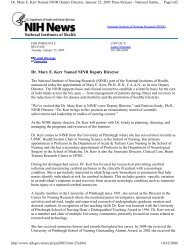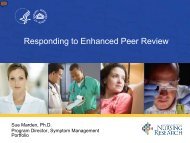Minutes - National Institute of Nursing Research - National Institutes ...
Minutes - National Institute of Nursing Research - National Institutes ...
Minutes - National Institute of Nursing Research - National Institutes ...
You also want an ePaper? Increase the reach of your titles
YUMPU automatically turns print PDFs into web optimized ePapers that Google loves.
patient symptoms and genetic or other biologic or physiologic factors that might predict patientrelatedclinical outcomes.Dr. Henderson and her team have identified a link between unexplained abdominal pain andserotonin, mast cell activation, and pro-inflammatory mediators. Pilot data from the Brain-GutNatural History Study further indicate that an inflammatory mechanism, specifically chemokineCCL-16 is upregulated in patients with chronic abdominal pain <strong>of</strong> unknown origin. Thesefindings are consistent with other studies showing upregulation <strong>of</strong> CCL-16 in patients withulcerative colitis. Other work in Dr. Henderson’s laboratory has identified a microRNA signaturethat distinguishes between wellness and irritable bowel syndrome or chronic abdominal pain.This signature maps back to the colorectal miRNAome and might identify potential treatmenttargets. Dr. Henderson and colleagues are also exploring the molecular genetics underlying therelationship between stress and chronic abdominal pain.As part <strong>of</strong> the Brain-Gut Natural History Study, and in collaboration with investigators from theNIH Clinical Center, the <strong>National</strong> <strong>Institute</strong> <strong>of</strong> Diabetes and Digestive and Kidney Diseases, theUniversity <strong>of</strong> Washington, and Psychology S<strong>of</strong>tware Tools, Inc., Dr. Henderson’s team hascreated the Gastrointestinal Pain Pointer (GIPP) to address the need for improvedcharacterization <strong>of</strong> pain and real-time subjective and objective pain assessments. The GIPPutilizes an interaction touch-screen personal computer which allows the patient to identify wheretheir pain is occurring and how intense that pain is, all in real time. The computer captures thisinformation using existing pain descriptors, and devices attached to the computer take readingson sympathetic and parasympathetic factors such as heart rate and blood pressure. Dr. Hendersonand colleagues have shown the GIPP to be a valid and reliable instrument. Thus GIPP <strong>of</strong>fers13












